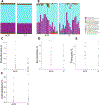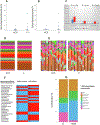Investigating intestinal permeability and gut microbiota roles in acute coronary syndrome patients
- PMID: 35506046
- PMCID: PMC9059675
- DOI: 10.1016/j.humic.2019.100059
Investigating intestinal permeability and gut microbiota roles in acute coronary syndrome patients
Abstract
Background: Acute Coronary Syndrome (ACS) is a leading cause of morbidity and mortality. Perturbed gut- microbiota (dysbiosis) and increased intestinal permeability (leaky-gut) with translocation of bacterial antigens, play critical role in obesity and metabolic syndrome, which are also major ACS risk factors. Additionally, Trimethylamine-N-Oxide (TMAO), a metabolite produced by phylum Proteobacteria in gut is implicated in developing ACS. As Proteobacteria is a major source of translocated antigen lipopolysaccharides (LPS), we hypothesized that ACS patients have leaky-gut condition characterized by dysbiosis with increased Proteobacteria, leading to elevated blood levels of TMAO and LPS.
Methods: In a pilot case-control study, we enrolled 19 ACS patients (within 72-h of cardiac events) and 19 healthy-controls. Gut barrier function was determined using lactulose-to-mannitol urinary excretion ratio (L/M ratio). Stool microbiome composition was examined using16S sequencing and predictive functional analysis for LPS biosynthesis pathway by PICRUSt tool. Serum TMAO and LPS levels were measured.
Results: ACS patients had increased Gammaproteobacteria compared to controls:1.8 ±3.0 vs. 0.2 ±0.4% (P =0.04). Though Proteobacteria level was increased but not statistically significant: 4.1 ±3.8 vs. 2.1 ±1.7% (P =0.056). L/M-ratio was three times higher in ACS patients; 0.06 ±0.07 vs 0.023 ±0.02, (P =0.014). Surprisingly, there was no difference in the mean serum LPS or TMAO levels. However, PICRUSt analysis indicated increased Proteobacteria population increasingly contributed to LPS biosynthesis in ACS patients only.
Conclusions: ACS patients likely to have leaky-gut and perturbed gut microbiota. Further studies are required to precisely define the role of dysbiosis in ACS.
Keywords: Acute coronary syndrome; Dysbiosis; Endotoxins; Intestinal permeability; Proteobacteria; TMAO.
Conflict of interest statement
Competing interests There is no conflict of interest by any of the authors of this study.
Figures




References
-
- Lynch SV, Pedersen O. The human intestinal microbiome in health and disease. N Engl J Med 2016;375(24):2369–79. - PubMed
-
- Singh S, Singh H, Loftus EV Jr, Pardi DS. Risk of cerebrovascular accidents and ischemic heart disease in patients with inflammatory bowel disease: a systematic review and meta-analysis. Clin Gastroenterol Hepatol 2014;12(3):382–93. - PubMed
Grants and funding
LinkOut - more resources
Full Text Sources
Research Materials
